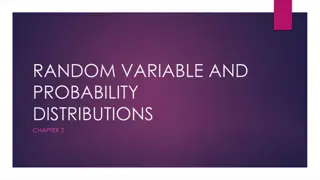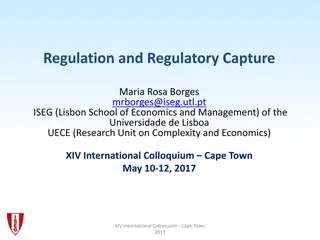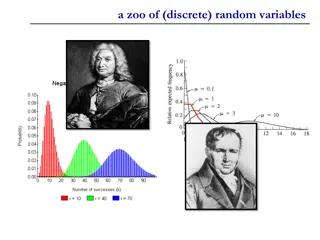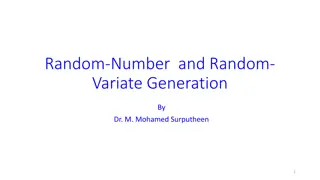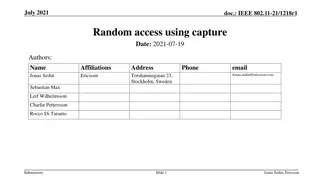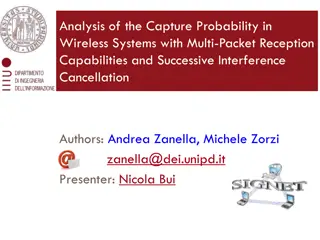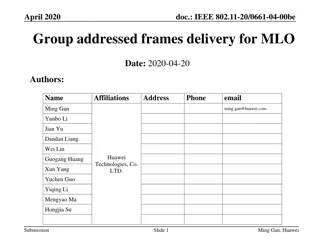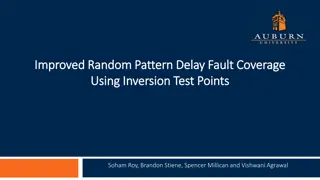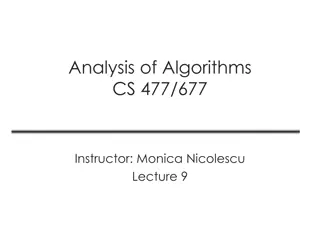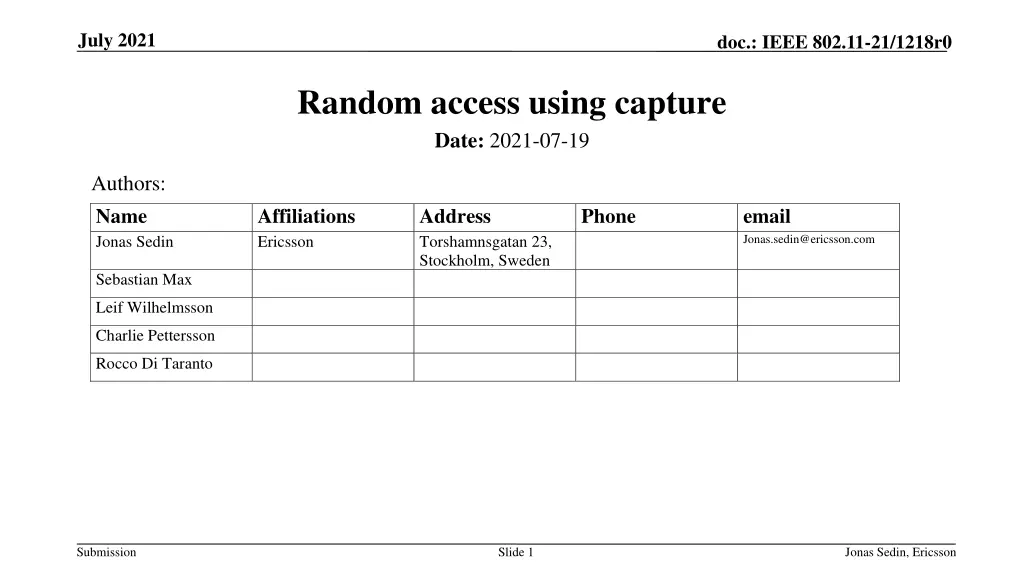
IEEE 802.11 Improving Random Access Efficiency
Explore ways to enhance random access efficiency in IEEE 802.11 networks, focusing on delivering Buffer Status Reports and reducing contention through advanced methods like UORA. Considerations include delay reduction, power ramping, and spatial streams utilization.
Download Presentation

Please find below an Image/Link to download the presentation.
The content on the website is provided AS IS for your information and personal use only. It may not be sold, licensed, or shared on other websites without obtaining consent from the author. If you encounter any issues during the download, it is possible that the publisher has removed the file from their server.
You are allowed to download the files provided on this website for personal or commercial use, subject to the condition that they are used lawfully. All files are the property of their respective owners.
The content on the website is provided AS IS for your information and personal use only. It may not be sold, licensed, or shared on other websites without obtaining consent from the author.
E N D
Presentation Transcript
July 2021 doc.: IEEE 802.11-21/1218r0 Random access using capture Date: 2021-07-19 Authors: Name Jonas Sedin Affiliations Ericsson Address Torshamnsgatan 23, Stockholm, Sweden Phone email Jonas.sedin@ericsson.com Sebastian Max Leif Wilhelmsson Charlie Pettersson Rocco Di Taranto Submission Slide 1 Jonas Sedin, Ericsson
July 2021 doc.: IEEE 802.11-21/1218r0 Abstract Random access can be improved outside of resource efficiency It is also important to consider what random access is used for In the case where random access is used for delivering BSR it is important to consider the delay We propose a method that could improve the delay when using UORA to deliver BSR using capture and power ramping Submission Slide 2 Jonas Sedin, Ericsson
July 2021 doc.: IEEE 802.11-21/1218r0 Background Random access for 11be has been discussed in several contributions [1] considers improving UORA by utilizing spatial streams potentially increasing the number of resources by the number of spatial streams per RU [2] considers reusing NFRP procedures borrowed from 11ax to increase the capacity to notify the AP that the STA needs to be scheduled Both of the contributions considers the random access efficiency to be low In order to improve random access, it should be considered how random access is used Submission Slide 3 Jonas Sedin, Ericsson
July 2021 doc.: IEEE 802.11-21/1218r0 Random access use case in 11be One of the main use cases for 11ax UORA is to deliver Buffer Status Reports This is particularly useful when there are many devices in the BSS whose data may arrive at any point and the AP uses OFDMA to schedule its users The BSRP trigger frame may include a field that makes the BSR transmitted using UORA This allows the AP to control the BSS to reduce contention, which allows for more efficient operations through AP control this is key if there are a lot of devices In this case not only UORA efficiency is important but also the uplink delay distribution caused by UORA Submission Slide 4 Jonas Sedin, Ericsson
July 2021 doc.: IEEE 802.11-21/1218r0 Random access in 11be In UORA there may be collisions between STAs As the received power is controlled by the AP - if two devices collide it is likely that none of the UORA transmissions will be correctly decoded This means that a collision will cause two failures However if the received power levels from the two STAs would be different - capture might be possible If the received power level are more than 3 dB it is likely that a collision would result in one failure and one success Thus we suggest that UORA introduce the ability for devices to have different powers This we envision could be done through power ramping Submission Slide 5 Jonas Sedin, Ericsson
July 2021 doc.: IEEE 802.11-21/1218r0 Random access with capture and power ramping Different received powers in UORA can be achieved through Power ramping Thus a STA starts at a lower transmitted power level and ramps it up successively until it succeeds This can be done by for instance having a set of AP received power levels to use with each attempt Randomly selecting powers The powers can be from a set of AP received power levels This should on average reduce the delay of random access as a collision may only cause one failure rather than two Submission Slide 6 Jonas Sedin, Ericsson
July 2021 doc.: IEEE 802.11-21/1218r0 Simulation setup Consider the use case of delivering BSR using UORA Consider the following: Single BSS scheduling using UORA A set of sensor STAs with sensor traffic model The STAs have sensor data arriving every 10 ms In this traffic scenario, OFDMA vastly outperfoms EDCA The BSRP that triggers UORA is sent every 10 ms We thus look at the delay for the STA to deliver the uplink data packet Submission Slide 7 Jonas Sedin, Ericsson
July 2021 doc.: IEEE 802.11-21/1218r0 Simulation setup cont We test the following: No ramping nor capturing applied Ramping 1: Ramping with 4 steps = {0, -3, -6, -9} dB Ramping 2: Ramping with 2 steps = {0, -3} dB Random 1: Random values selected from set of 4 values = {0, -3, -6, -9} dB We also look at the 50th and 95th percentile We can see that 50th and 95th percentile UL delay is improved compared to no ramping Submission Slide 8 Jonas Sedin, Ericsson
July 2021 doc.: IEEE 802.11-21/1218r0 References [1] 11/21-0400r0 Enhanced UORA, Yanyi Ding [2] 11/20-1903r3 Random access for 11be, Stephane Baron Submission Slide 9 Jonas Sedin, Ericsson



